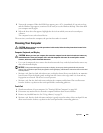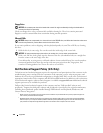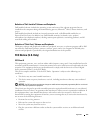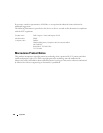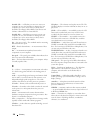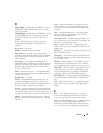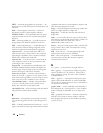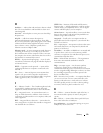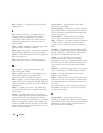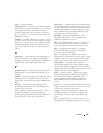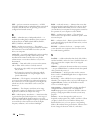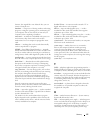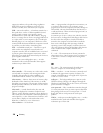
Glossary 173
H
hard drive — A drive that reads and writes data on a hard
disk. The terms hard drive and hard disk are often used
interchangeably.
heat sink — A metal plate on some processors that helps
dissipate heat.
help file — A file that contains descriptive or
instructional information about a product. Some help
files are associated with a particular program, such as Help
in Microsoft Word. Other help files function as stand-
alone reference sources. Help files typically have a
filename extension of .hlp or .chm.
hibernate mode — A power management mode that saves
everything in memory to a reserved space on the hard
drive and then turns off the computer. When you restart
the computer, the memory information that was saved to
the hard drive is automatically restored.
HTML — hypertext markup language — A set of codes
inserted into an Internet web page intended for display on
an Internet browser.
HTTP — hypertext transfer protocol — A protocol for
exchanging files between computers connected to the
Internet.
Hz — hertz — A unit of frequency measurement that
equals 1 cycle per second. Computers and electronic
devices are often measured in kilohertz (kHz), megahertz
(MHz), gigahertz (GHz), or terahertz (THz).
I
IC — Industry Canada — The Canadian regulatory body
responsible for regulating emissions from electronic
equipment, much as the FCC does in the United States.
IC — integrated circuit — A semiconductor wafer, or
chip, on which thousands or millions of tiny electronic
components are fabricated for use in computer, audio, and
video equipment.
IDE — integrated device electronics — An interface for
mass storage devices in which the controller is integrated
into the hard drive or CD drive.
IEEE 1394 — Institute of Electrical and Electronics
Engineers, Inc. — A high-performance serial bus used to
connect IEEE 1394-compatible devices, such as digital
cameras and DVD players, to the computer.
infrared sensor — A port that allows you to transfer data
between the computer and infrared-compatible devices
without using a cable connection.
integrated — Usually refers to components that are
physically located on the computer’s system board. Also
referred to as built-in.
I/O — input/output — An operation or device that enters
and extracts data from your computer. Keyboards and
printers are I/O devices.
I/O address — An address in RAM that is associated with
a specific device (such as a serial connector, parallel
connector, or expansion slot) and allows the processor to
communicate with that device.
IrDA — Infrared Data Association — The organization
that creates international standards for infrared
communications.
IRQ — interrupt request — An electronic pathway
assigned to a specific device so that the device can
communicate with the processor. Each device connection
must be assigned an IRQ. Although two devices can share
the same IRQ assignment, you cannot operate both
devices simultaneously.
ISP — Internet service provider — A company that allows
you to access its host server to connect directly to the
Internet, send and receive e-mail, and access websites.
The ISP typically provides you with a software package,
user name, and access phone numbers for a fee.
K
Kb — kilobit — A unit of data that equals 1024 bits. A
measurement of the capacity of memory integrated
circuits.
KB — kilobyte — A unit of data that equals 1024 bytes
but is often referred to as 1000 bytes.
key combination — A command requiring you to press
multiple keys at the same time.



